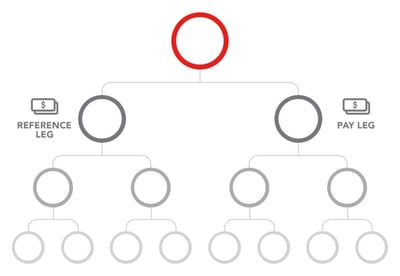
What’s a Binary Plan? [Binary Pay Leg Commission Basics, Pros + Cons]
What’s a Binary Plan? [Binary Pay Leg Commission Basics, Pros + Cons]
Binary compensation plans are a direct selling industry staple. And generally, the jury’s split pretty evenly on how they’re received—distributors either love binaries’ unique rules and strategies or are frustrated with their inflexibility. Still, it’s a major contender among the three main comp plan types and has brought a lot of companies huge success. Read on to learn about how binaries differ from breakaway and unilevel plans and the pros and cons of using one in your company.

Binary Basics
A binary compensation plan is defined by the way it’s structured. The word binary means that there are only two options—on or off, white or black, 0 or 1. When we’re talking about binary compensation structures, the two available options are for building a downline. Distributors have only two options for placing new recruits—on the left or the right side (or leg) of their downline. This is the biggest hallmark of a binary plan—every distributor can only have up to two recruits on the first level beneath them.

Learn more about our commissions consulting services here.
Another thing you should know about binaries is the fact that their commission runs are typically a lot different from the kind you see in breakaway and unilevel plans. Binaries, for example, pay faster than other types and compensate on unlimited downline depth. We’ll explain a little more about that later, but for now let’s take a second to go over how to earn commissions in a binary plan.
The pay leg commission
MLM binaries pay their salesforce with something called a pay leg commission. The rules usually go something like this: distributors are paid based on downline sales volume (just like in a breakaway or unilevel), but in most binary plans, only one leg’s earnings count toward commissions. And that leg is the pay leg.
The pay leg is almost always the lesser-earning of the two sides. The other leg is commonly called a reference leg:

Most binary plans don’t pay any commissions for the reference leg’s earnings, but some have decided to include the reference leg in a small part of the commissions—for example, two-thirds of commission earnings could come from the pay leg, and the other third could be generated by the reference leg.
Binary Pros
Incentivizes a supportive build strategy
Some people are surprised to learn that the binary building structure is one of the best in the industry for fostering teamwork and motivation for distributor groups. When they hear that representatives are only paid on the lesser-earning leg and “mis out” on strong leg volume, they’re doubtful that this practice works in a distributor’s best interest. So, let’s go over an example:
Consider, for instance, that a leader has two very different downline legs—one that came with a lot of team-building and sales experience and one that didn’t. If she was only paid on the higher-performing downline, she’d naturally want to spend all of her time building it up and helping it succeed. The other side, without any support or attention, would crumble.
Paying on the lesser-earning leg motivates leaders to build both sides equally to maximize income flow and their own commissions.

Capped commissions protect your payout
Remember earlier, when we talked about how binary payouts are very different than in other commission types? Let’s get into that a little more.
It’s pretty common for binary compensation plans to pay distributors on unlimited downline depth in their pay legs, usually about 10% on each qualifying sale. If you’re following along closely, you’ve probably figured out that unlimited commissions also means unlimited payout, and you’re right! So how can binaries afford to run this model? The secret is capped commissions.
The practice of capping commissions is an invaluable tool for direct selling binary plans.
Essentially, this means that you decide to cut off all payouts at your budgeted amount and then give distributors a proportion of what they’ve earned. This way, commission payouts stay controlled and keep your budget from capsizing.
If you have a binary plan, make sure to talk to your compensation strategy team to come up with a payout system that makes sense for your company and, most importantly, protects your budget.
Binary Cons
The lingering “do-nothing” mindset
Unfortunately, binary compensation plans have a history of being mispromoted by leaders. In the past, distributors used the idea of spillover to get new representatives to join. Here’s what it looks like:

Eager business builders showed recruits a binary model, with its limited number of downline spots, and promised them their upline would build their downline—hyperactive leaders above them would find so many people to join the business, the new recruits’ downline slots would fill all on their own and send residual income straight into their pockets. Basically, the message was, “your upline will build your downline.”
This idea and the repercussions that came from it have been really damaging for the binary plan’s reputation. It’s true that some spillover can happen in binaries, but, when it happens, it’s definitely the exception to the rule. Distributors who expect commission checks without working to earn them end up misled and disappointed.
Promised inheritance
Another popular selling point for binary compensation plans is the fact that new distributors are sometimes told they can “inherit” a massive reference leg with huge earnings potential when they join a successful leader’s downline.
Using a big reference leg as motivation can actually be a useful tool as long as leaders clearly communicate the comp plan rules, too. New recruits need to understand how pay leg commissions work and that building their own pay leg is the only way to take advantage of a reference leg.
Conclusion
Binary compensation plans really are one of a kind. The structure, commissions, and building strategies are totally unique and give it a special advantage over the other compensation models in the industry. There’s a lot of room for you and your strategy team to discover your own insights for leveraging the strengths of a binary in your own plan—a structure that’s simple to explain and tailor to your products and goals has endless possibilities.
Remember, though, that binary structures can come with some baggage. Just as in any MLM, binaries need variety and clear compensation plan rules that are easy for any distributor to reference as they start and grow their business. Making communication a priority and taking advantage of supplementary commissions and promotions will make a big difference for any binary in the industry today.
To learn more about improving your MLM compensation plan, check out InfoTrax’s commissions consulting services here.





